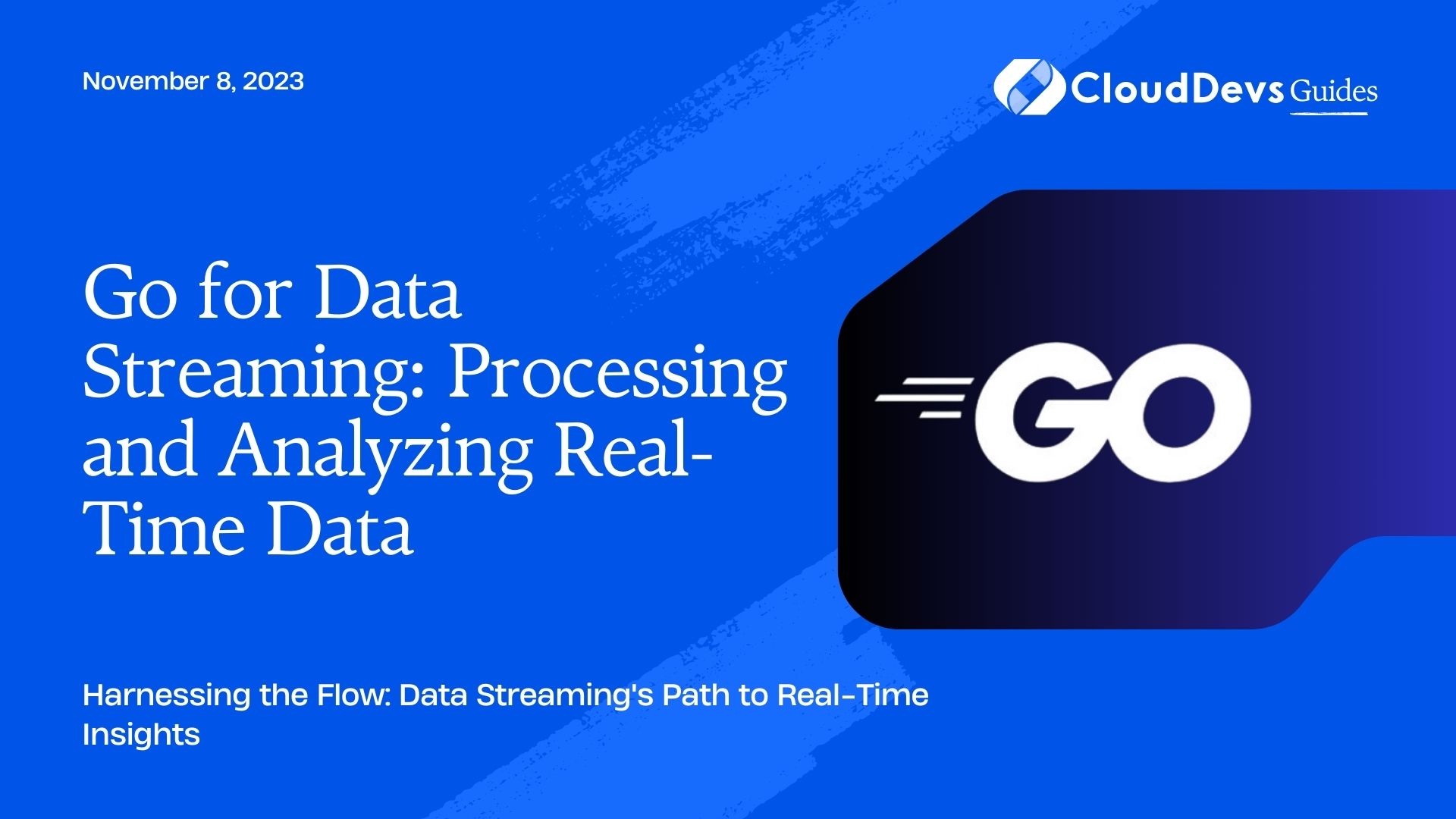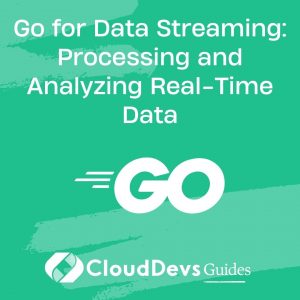Go for Data Streaming: Processing and Analyzing Real-Time Data
In today’s fast-paced world, businesses need to make decisions based on real-time data to stay competitive and responsive. Traditional batch processing methods may not suffice, as they often result in outdated information. This is where data streaming comes into play. In this blog, we’ll delve into the world of data streaming, covering its fundamentals, processing techniques, analysis, and the significant advantages it offers to businesses.
1. Understanding Data Streaming
1.1 What is Data Streaming?
Data streaming is a method of processing and transmitting data records in a continuous flow. Unlike traditional batch processing, where data is collected, stored, and processed in chunks, data streaming handles data in real-time or near real-time. In essence, data streaming treats data as a never-ending stream, making it available for processing as soon as it is produced.
1.2 How Does Data Streaming Work?
Data streaming involves several key components:
- Data Sources: These are the origins of your data, which can include IoT devices, log files, sensors, user interactions, and more.
- Data Ingestion: Data is ingested or collected from sources and made available for processing. This is a crucial step in the data streaming pipeline.
- Data Processing: Once ingested, data is processed in real-time. This may involve filtering, aggregation, enrichment, and various transformations.
- Data Storage: Processed data can be stored for historical analysis or used for further downstream processing.
- Data Analysis: Real-time data analytics tools are employed to gain insights from the streaming data.
1.3 Why Choose Data Streaming?
Data streaming offers several advantages over traditional batch processing:
- Real-time Insights: Businesses can make decisions based on up-to-the-minute information, improving their agility and competitiveness.
- Scalability: Data streaming platforms can scale horizontally to handle increasing data volumes.
- Reduced Latency: With data streaming, there is minimal delay between data generation and analysis, reducing latency in decision-making.
- Fault Tolerance: Many data streaming frameworks offer built-in fault tolerance, ensuring data integrity and system reliability.
- Enhanced Customer Experience: Real-time data can be used to personalize user experiences, leading to higher customer satisfaction.
Now that we understand the basics, let’s move on to how real-time data is processed within the data streaming paradigm.
2. Processing Real-Time Data
2.1 Data Sources and Ingestion
To process real-time data, you first need to identify your data sources. These sources can be diverse, ranging from social media feeds and sensor data to user interactions on your website. Once identified, you need to ingest this data into your streaming platform.
Code Sample: Apache Kafka
python
from kafka import KafkaProducer
# Create a Kafka producer
producer = KafkaProducer(bootstrap_servers='localhost:9092')
# Ingest data into a Kafka topic
producer.send('my_topic', key='key', value='value')
Apache Kafka is a popular choice for data ingestion in data streaming pipelines. It provides durability, scalability, and fault tolerance, making it ideal for handling real-time data streams.
2.2 Data Transformation
After ingesting data, you often need to transform it to extract valuable insights. Transformation can involve filtering out irrelevant data, aggregating statistics, or enriching data with additional information.
2.3 Event Time vs. Processing Time
In data streaming, it’s essential to distinguish between event time and processing time. Event time refers to the time when an event occurs, as recorded in the data source. Processing time, on the other hand, is the time when the data is processed by the streaming system. Handling event time correctly is crucial for accurate analysis, especially when dealing with out-of-order events.
2.4 Code Sample: Apache Kafka Stream Processing
python
from kafka import KafkaConsumer
from kafka import KafkaProducer
# Create a Kafka consumer
consumer = KafkaConsumer('my_topic', group_id='my_group', auto_offset_reset='earliest')
producer = KafkaProducer(bootstrap_servers='localhost:9092')
# Process incoming data
for message in consumer:
# Perform data transformation and analysis
result = process_data(message.value)
# Send the result to another Kafka topic
producer.send('results_topic', value=result)
In this code sample, we use Apache Kafka for both data ingestion and streaming processing. It consumes data from ‘my_topic,’ processes it, and sends the results to ‘results_topic.’
3. Analyzing Real-Time Data
3.1 The Importance of Real-Time Analytics
Real-time analytics allows businesses to gain immediate insights from streaming data. This is particularly valuable in scenarios where timely decisions are critical, such as fraud detection, stock trading, and monitoring network performance.
3.2 Real-Time Data Visualization
Visualizing real-time data is essential to make sense of the continuous stream of information. Dashboards and data visualization tools enable users to monitor key metrics and trends in real time.
Code Sample: Apache Flink for Real-Time Analytics
python
from pyflink.datastream import StreamExecutionEnvironment
from pyflink.table import StreamTableEnvironment
# Create a StreamExecutionEnvironment
env = StreamExecutionEnvironment.get_execution_environment()
# Create a StreamTableEnvironment
table_env = StreamTableEnvironment.create(env)
# Define and execute real-time SQL queries
table_env.execute_sql("""
SELECT product_id, COUNT(*) as purchase_count
FROM purchases
GROUP BY product_id
""")
Apache Flink is a powerful framework for real-time data analytics and processing. It supports SQL queries on streaming data, making it easy to extract valuable insights.
4. Benefits of Data Streaming
4.1 Improved Decision-Making
One of the most significant advantages of data streaming is the ability to make informed decisions promptly. Whether it’s adjusting pricing in response to market changes or identifying and mitigating issues in real time, data streaming empowers organizations to act swiftly.
4.2 Enhanced Customer Experience
Real-time data streaming enables personalized customer experiences. By analyzing user behavior in real time, businesses can recommend products, tailor content, and provide customer support proactively.
Code Sample: Real-Time Dashboard
javascript
// Update a real-time dashboard with streaming data
function updateDashboard(data) {
// Update charts, graphs, and user interfaces
// to reflect the latest streaming data
}
Real-time dashboards, like the one shown in this code sample, can display critical metrics and insights to decision-makers in real time.
4.3 Scalability and Fault Tolerance
Data streaming platforms are designed for scalability. As data volumes increase, you can easily add more resources to your streaming cluster to handle the load. Additionally, many streaming frameworks offer built-in fault tolerance mechanisms, ensuring that data is not lost in case of system failures.
5. Challenges and Best Practices
5.1 Overcoming Streaming Challenges
While data streaming offers numerous benefits, it also comes with challenges. Managing high-velocity data streams, ensuring data quality, and dealing with out-of-order events are some of the common challenges in data streaming pipelines.
5.2 Ensuring Data Quality
Data quality is paramount in data streaming. Inaccurate or corrupted data can lead to flawed analyses and decisions. Implementing data validation and cleansing processes is crucial to maintain data quality.
Code Sample: Error Handling
python
def process_data(data):
try:
# Data processing logic
result = perform_processing(data)
return result
except Exception as e:
# Handle errors and log them
log_error(e)
return None
Error handling, as demonstrated in this code sample, is vital to prevent data processing failures from impacting the entire streaming pipeline.
Conclusion
Data streaming has revolutionized the way businesses process and analyze real-time data. By leveraging data streaming technologies like Apache Kafka and Apache Flink, organizations can make faster and more informed decisions, enhance customer experiences, and gain a competitive edge. However, it’s essential to address the challenges of data streaming with best practices in data quality and error handling.
As the world continues to generate an ever-increasing amount of data, data streaming will play an increasingly vital role in harnessing the power of real-time information. Embracing data streaming is not just a technological choice but a strategic one for businesses looking to thrive in the digital age. So, go for data streaming and unlock the potential of real-time data analytics. Your business’s future may depend on it.
Table of Contents







